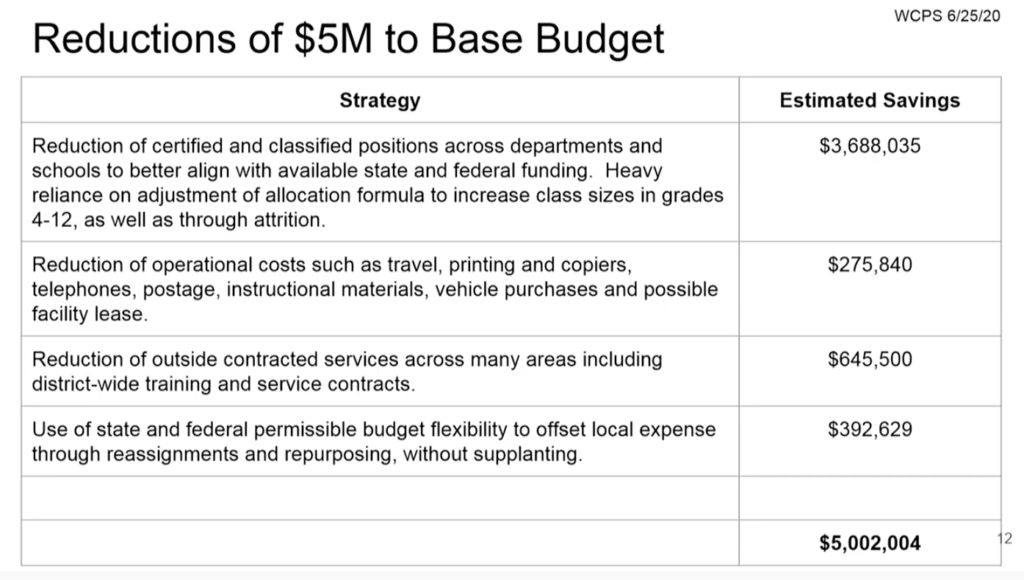
Teaching position cuts, increased class sizes likely coming, but Central Office leadership not on chopping block
Wayne County Public Schools’ temporary — and as of June 26 interim — superintendent has delivered the first results from the district’s efforts to unravel its nearly $5 million deficit.
And on the list of solutions are more students in classrooms, plans to reduce the number of teaching positions in the county and cuts to training opportunities.
What is not on the list is a significant cut in the district’s Central Office staffing — one of the areas the Rives & Associates auditor pointed to as an area of concern during her June 3 presentation that sent shockwaves through the district and county.
Dr. James Merrill told the Board of Education Thursday that there is still more information to decipher on the district’s complete financial picture, adding that he and Central Office staff, as well as School Operations Specialists, a consulting firm hired to review the district’s procedures and finances, are waiting for July to close out the year to get a firm read on what the district will have to work with next year and what it will owe.
With Merrill at the meeting were five Central Office assistant superintendents, including Dr. Tim Harrell, support services; Dr. David Lewis, accountability and technology; Dr. Yvette Smith Mason, human resources and professional development; Tamara Berman-Ishee, teaching and learning; and Dr. Marcia Manning, student services and innovative programming.
Lewis opened the meeting by discussing the district’s average daily membership (ADM), which the state uses to calculate how many teaching positions it will fund.
Lewis said while the state is expecting WCPS to see an increase this coming year, he advised that the board not rely too heavily on that estimate — which is 18,032, slightly higher than 2019-20’s population of 17,997.
In the last several years, he said, the district’s actual ADM “came in lower” than the state’s prediction — 447 fewer students in 2018-19 and 568 fewer students in 2019-20.
He also pointed out that the county schools’ enrollments have been declining for the last five years, while charter school enrollments have increased.
Lewis also discussed per pupil expenditures, which were $6,940 from the state, $1,517 from local funds and $813 from federal funding. The latest amounts provided were from 2018-19.
None of those figures included child nutrition funding.
Mason was called on to discuss the prior year turnover count in the district, which included 149 teachers, 24 custodians, 22 bus drivers, 3 administrators, 53 instructional assistants, 41 cafeteria assistants and 17 maintenance employees.
The numbers, which included some other positions as well, are from the reporting period of July 1, 2019, through June 30, 2020.
Mason said the district is continuing to recruit in some critical need areas.
District hiring, except in cases of special areas that must be filled — specifically if there is no teacher available to provide the instruction or the position is mandated such as an exceptional children’s need — is frozen, Merrill said.
Merrill said the district’s debt drivers — the money that must be made up to bring the district back into the black — is about $5 million — still an estimate.
“These are recurring expenses,” he said.
That means, they are already built into the past budget. So, cutting back on that spending “will call for permanent structural reductions to state and local budgets.”
Merrill said the money will not come back into future budgets unless there are increased appropriations from state and local entities.
He also advised that both the state and Wayne County are “at risk of reductions” this year.
The ADM is a wild card, too, considering the ongoing concerns about COVID-19 and what the state is planning to do with school this fall, he added.
“We may not get the students back we were counting on,” Merrill said.
The other debt driver is the $3 million loan to the Food Services Fund, a one-time expense, which, once paid back, will be off the district’s obligations.
Merrill said he is still working with the state on the terms of the loan he negotiated to cover teacher stipends and June paychecks, which would be another expense to factor in as well.
The soon-to-be-interim superintendent also pointed out that the district would have to take into account increases in benefits, retirement matches and other expenses for teachers and staff as well.
Vacancies reported from May 15 to June 23, 2020, include 88 teachers with a potential annual savings of $4,560,908; three administrators, at a savings of $181,000; and 59 classified employees at a savings of $1,990,000.
Berman-Ishee said that the district is currently under a rolling freeze, which means that only “must fill” positions will be on the list — to meet the K-3 class size mandate, for example, or for a single position where there is no other employee to cover the need.
She added that if the district were to win a grant for additional instruction or programming, there would have to be an administrator for that addition.
She advised board members that the district would have to do a “strategic balance” to get programs and classes for students and the personnel to provide them.
“Protecting programs for students remains our top priority,” she said.
Board member Len Henderson asked about remediation programs — especially important, he said, for those students who might be behind after being out of school for four to five months.
“We are not allowed to drop the ball on that,” Ishee said.
Merrill outlined the reductions preliminarily proposed to get the district back on track.
They include:
• Reduction of certified and classified positions across departments and schools to better align with available state and federal funding. Heavy reliance on adjustment of allocation formula to increase class sizes in grades 4-12 as well as through attrition: Estimated savings of $3,688,035.
• Reduction of operational costs such as travel, printing and copiers, telephones, postage, instructional materials, vehicle purchases and possible facility lease: Estimated savings of $275,840.
• Reduction of outside contracted services across many areas including district-wide training and service contracts: Estimated savings of $645,500.
• Use of state and federal permissible budget flexibility to offset local expense through reassignments and repurposing, without supplanting: Estimated savings of $392,629.
“The big solver of this will be increasing class sizes,” Merrill said.
Putting more students in classrooms will allow more positions to be culled and to keep as many core and enhancement classes as possible, he said.
In grades 4-8, that class size increase breaks down to: increase classes by 2 students, 18 positions saved; by 4 students, 28 positions saved; and by 5 students, 41 positions saved.
Previously, the district had recommended increasing class sizes by four.
The district had hoped to keep class sizes at 26 students as a cap, Lewis said.
“We aren’t going to be able to afford that anymore,” he said.
He added that creating that 30 student per classroom goal will be harder at smaller schools.
“The impact of one position is greater than a position at a larger school,” Lewis said.
The district is proposing a two-year process for adjusting the allocation — teaching positions — in grades 9-12.
The first year is a target average class size of 30 students in core classes, without reductions in course offerings for students. The proposed reduction would be 20 teachers.
The second year would be allocations based on the state allotment formula with allowances based on ADM, which would include additional teachers above what the state provides based on the number of students in the school. The proposed reduction would be 15 additional teachers.
Previously the board had considered a 25 student per class limit.
The extra classes — those not included in the state allocation — are what contributed to the deficit.
“The extras we are accustomed to providing put us way over the allocation,” Lewis said.
Principals will have tough decisions to make on what classes — and extras — they will have the staff to provide, he said.
Merrill said the state is not offering enough funding to meet the staffing needs of the district, and that Wayne County will have “to work backward to the state allocation” to mend its budget shortfall.
The solution is not simply to cut classes and positions, Lewis said. While there will be some exploration of student interest vs. available positions to teach the classes, and creative ways to meet the needs of students like shared teachers between schools, the ultimate goal is to make students’ needs top priority.
“We are trying desperately not to eliminate opportunities for students,” Lewis said.
In addition to the staffing changes, Merrill also announced some Central Office cuts, which included not filling three positions for a total savings of $110,000 and $125,000 in maintenance contracts.
Superintendent training, travel and advertising were also cut for a savings of $42,000; transportation contract services at a savings of $50,000 as well as $15,000 for departmental travel and $35,000 for board training and supplies.
The cuts also include accreditation for high schools only — a savings of $25,000.
Merrill also announced some additional small ticket savings — mandatory direct deposit, a rolling hiring freeze until the district hits $500,000, returning budget management to the departments and re-evaluating contract services as well as re-examining personnel contract costs vs. employee salary scales.
The last means looking at contracted services to see if money could be saved by simply hiring a district employee to perform those services, Merrill explained.
Merrill and the cabinet members also discussed “anticipated turmoil” — the consequences of the proposed changes to the budget.
Berman-Ishee said the first concern is the impact the cuts would have on the students.
“Quality education is still our primary goal,” she said. “All of this makes that more challenging.”
She added that flexibility with placements for teachers will now be much more difficult.
“In doing what we are doing now, staff has to be placed where there are vacancies,” she said.
There will also be stresses on the offerings for teachers to meet professional education requirements — and how those courses will be offered.
Berman-Ishee added that she and other administrators will work to provide more training internally, which will be a significant task.
She added that teachers will bear the brunt of the increased class sizes, which will mean additional work and stress for them once positions are eliminated.
And then there is the specter of COVID-19, and how the state’s directives will affect class offerings and how education will be handled this fall.
She said she is certain that teachers and administrators will step up.
“That is our reality,” she said. “That is our challenge and that is what we are going to do.”
Merrill said the district’s financial goals for 2020-21 include quarterly financial reports for both the BOE and the county commissioners as well as a positive fund balance by June 2021. Establishing financial processes and procedures is also a priority, he said.
Next steps include a June 29 board meeting where the interim budget resolution and School Operations Specialists activity report will be presented.
Merrill said the district will present the board with a balanced budget proposal in August.
Editor’s Note: This story has been modified to clarify that the $110,000 in cuts noted by Merrill represent not filling three — not one — vacant positions.

A loaded discussion

Fighting for their lives

Goldsboro loses a giant

“I’m a flippin’ hurricane!”
Public Notices — Jan. 4, 2025

Belting it out

Legendary

Final Four!


